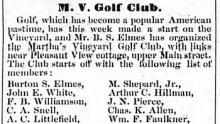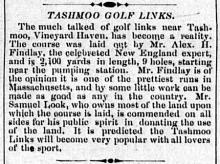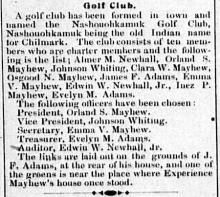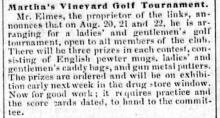Golf is such an indispensable part of Island recreation that it seems impossible to imagine the Vineyard without it. However, in the nineties the game was played only by a few ambitious souls who now with excusable pride call themselves the founders of golf here. The various courses on the Island have no very definite dates to make their beginnings, as long before the clubs were officially founded, the game was being played on semi-pastures and fields.
A course which is no longer in existence claims to be the oldest on the Island. This was planned, laid out and played on by the group of boys forming the Highland Athletic Club. This club was started in the 1890s and had a singularly successful existence until its abolishment in the late summer of 1903. The late Frank Ferris of East Chop was in charge of the boys and organized all kinds of sports. Track meets were held every summer and swimming regattas were extremely popular. Every Sunday the lads met at the home of Mr. Ferris, and it was there that the final banquet of the club was held.
Among the many boys who were members, the three Meleneys, Frank L., Clarence C., and Henry E., were prominent. They can recall all the difficulties entailed in setting out the nine holes of the links and the hard work required to keep the course in shape. In those days, not only here but on the best of links, sand greens were the only ones used. The holes here were necessarily short, but the little club enjoyed its private links as well as its many other sports. As the boys grew older those whose initiative had founded the organization drifted from the Island to various ports of business, the new generation of younger boys seemed to lack their predecessors’ vigor, and the little club was dissolved with a last sad but delightful banquet.
The Vineyard Haven golf addicts were not far behind the Highland lads and these players ploughed through fields that have now been transformed into the Tashmoo links. The greens then were of stubbly grass and the hazards were particularly terrifying in their natural contours. The holes were never properly laid out till a much later date, and enthusiastic players merely gained permission from Samuel Look to knock balls around a portion of his farm. The par in those days was a difficult fifty. Three of the establishers of this record were Peter Cromwell, Dr. John C. Rolfe and Charles H. Brown.
One of the hardest ordeals the triumvirate had to face was an old bull belonging to Farmer Look. For several seasons the bull had been as peaceful and benevolent of appearance as a purring pussy, but a radical change in his diet affected his good nature. Through a long winter Farmer Look had fed turnips to his bull for his daily meals. Now, with Peter Cromwell nourishing high hopes of breaking the fifty par with a particularly hefty drive, Señor Bull decided that the approaching ball was a little free turnip tea. Grasping the ball firmly in his gargantuan jaws, the bull ambled away from the green, with Charles Brown giving wild chase. When the bull was finally persuaded to drop his catch, Peter Cromwell’s lie was not only bad but he was a good number of yards behind his starting point. A heated altercation arose, “Was this a natural hazard of the course?” Both Brown and Rolfe agreed that it was and the bull and all his kind went down several pegs in Cromwell’s estimation.
Another member of Mr. Look’s farm was a frequent audience at the golf orgies. This was Jo Rogers. One day he appeared on the scene with a wooden driver made by his own hand from a seasoned oak limb. After challenging the trio, Rogers proceeded to outdrive them all with his home-made implement. Many were the adventures the three pioneers had on the links and one of the golfers, Charles Brown, went to other links in search of further excitement.
These were none other than nine of the eighteen holes now forming the Oak Bluffs course. Amateur players had laid out tees and greens on the Benjamin Davis farm owned by Frank Chase. Sand greens and rough fairways were obstacles here as on the other old links, but the first players enjoyed their game nevertheless.
Some of these early players were Dr. Harry Tucker, Horace Richards, Dr. Dorchester, and most of the male portion of the Hart clan. A caddy house was built soon after the game was started and an Englishman by the name of Ely became the first professional. Ely was not only an excellent player and instructor, but he was also a master hand at the craft of clubmaking. He had been a pupil of the famous Scottish professional Willie Dunn and had learned to play with leather balls stuffed with feathers. The mighty swatters today may become disconsolate over a few cuts in their prized balls but imagine their consternation if a too-hearty whack made the feathers fly!
After the club had been drifting along in a somewhat raw state for some years, Edward Mulligan, a promoter, decided to try his hand in making the club a success. It was Mulligan’s idea that the Oak Bluffs course could be ready the first part of May and thus draw the crowd of professionals who had finished playing in Florida and were waiting for the northern season to start. Due to the mild climate of the Vineyard, playing could commence at a far earlier date than on the mainland and the players could keep in practice in between the two seasons. Many here agree that Mulligan would have succeeded in his plans to make the Island course a by-word in the golfing world, but unfortunate circumstances led to Mulligan’s financial downfall.
The promoter was the owner of one of the first autos on the Island, an ancient two-cylinder French car. Driving past Tashmoo one day, Mulligan was utterly unaware that old Farmer Scott had taken his team into a side road out of the way of the dread machine. Despite the fact that the team had retired from the scene of action, one of the horses ran away and Scott was thrown out and killed. Faced not only with a charge of manslaughter but with other difficulties, Mulligan decided to accept Lyman Besse’s offer to buy the club. The dues had not paid the expenses of setting out the eighteen-hole course and the salaries of the really good professionals Mulligan had employed. One of these professionals had been the well known Finley, brother of the New Bedford instructor, and under his care the course had been improved until it had acquired a par of 76.
Under Mr. Besse and his colleagues, many well known professionals have added fame to the club’s name. Jim Hendry was the first of these, and in 1921 he was followed by Bill Cooper. Nineteen twenty-three saw Colin Dow officiating and in ’24 Fred Chisolm succeeded to the post. The following year James Andrews became professional and in turn was succeeded after a year by Tommy Attridge. Tom has capably filled this position ever since and is a familiar and well-beloved part of the club today.
Not only has the club instruction been kept up-to-date but under such supervisors as William J. Mills, John C. Rolfe, William Hart, and H.O. Phillips, many improvements have been made to the course and buildings. The clubhouse was built around 1910 and the present locker house a few years ago.
Although not in existence at the present time, the West Chop links were once a feature of that part of the Island. Around 1893 several of the West Choppers felt the need of exercise and organized a club. C. C. Jackson was president and E. P. Greenough, W. J. Badger, C. B. Gookin, R.G. Shaw and Dr. Homans were prominent in the association. From one of the West Chop residents who caddied there, many facts about the course have been ascertained. Six holes were played in the vicinity of the lighthouse, and what an accomplishment a par was on these links! Hazards were of such a natural luxuriousness that it was difficult to say where hazard ended and fairway began; greens were in such a rough state that mashies were quite in vogue for putting purposes. Little troubles like these were merely incentives to the true sporting blood of the West Chop golfers, and for several years the real enthusiasts played the course and liked it.
More recently, Robert L. Bigelow has cleared an extensive tract with the idea of converting it into a golf course. This land was heavily wooded, and following the conversion of the trees into cordwood Mr. Bigelow planned a crop cycle to bring the soil into proper condition for a golf course. After the removal of the stumps, it was planned to plant buckwheat and then rye, at least three years being necessary to accomplish the desired result. The tract is in the shape of an L, some two miles in length.
The first golf course in Edgartown was doubtless the Pine Side Golf Links, described in the Vineyard Gazette of twenty-five years ago as “an excellent reproduction of the original Scotch links.” This course was situated near the junction of the beach road to Oak Bluffs and the county road to Vineyard Haven, on the fields now owned by George Norton, in later years covered with young pines. Thirty years or more ago, this course was operated privately by a man named Elms and buses ran to it from the hotels. Subsequently it was maintained by the Edgartown Golf and Tennis Club, of which H.L. Wimpenney 2nd was treasurer. No Sunday playing was allowed. The course covered some 2,500 yards.
Golf was also played many years ago on the same land where the present course is laid out. The Rev. Frederick M. Cutler, Congregational minister of the day, is believed to have been one of the pioneers on this course and one of the early enthusiasts. The originators carried on for several years, and then the course was taken over by Charles F. Shurtleff, who used to hire the land for pasturing cows and took care of it. Judge Abner L. Braley and other summer residents of prominence drove and putted on this early course. The Rev. Mr. Pickells, Episcopal rector at the time, is recalled as one of the players.
No story of Vineyard golf would be complete without mention of the course on the land owned by Dr. Frank L. Marshall, Chappaquiddick. The Marshalls, the Seagers and other enthusiasts have played this six-hole layout for many years, and some of the clubs still used are relics of the early days of the sport in this country. The small greens are composed of clay and sand, and one feature is an elevated basin-like green, par of which is one stroke.
The most recent addition to the Vineyard golfing world is that of the nine hole course in Edgartown. Opened in 1926, the links immediately gained the admiration of all players. Overlooking Vineyard Sound and Trapp’s Pond, the holes are swept by cool ocean breezes. The charming green rolling contour of the country has made many compare the beauty of the land to famous courses in Scotland.
The course was sponsored by Cornelius S. Lee, and he gathered together the thirty-eight founders who started the club, which is limited to members and their guests. Two professionals usually share the season, James Soutar and his assistant, Charles Dunko, both of Tuxedo Park. Constant improvements have made this course most popular with Edgartown players.
No wonder golf is such a well-patronized pastime on the Vineyard. Not only is there a long line of past golfing achievements of which to be proud, but at present the three courses at Tashmoo, Oak Bluffs and Edgartown furnish all the golfer’s heart could desire. Situated in three of the beauty spots of the Island, the links combine interesting play with scenery lovely to every eye. How popular these clubs have become a glance at the many-people courses discloses. Here on the long rolling stretches of green, the only depression for the proverbial tired business man is that in which his ball is obstinately resting, and he never complains if his stock of golfing lore brings him a par of less than one hundred!










Comments